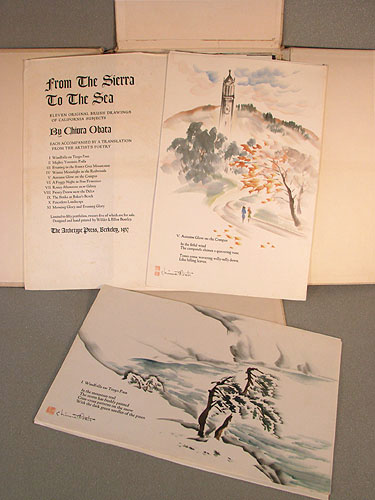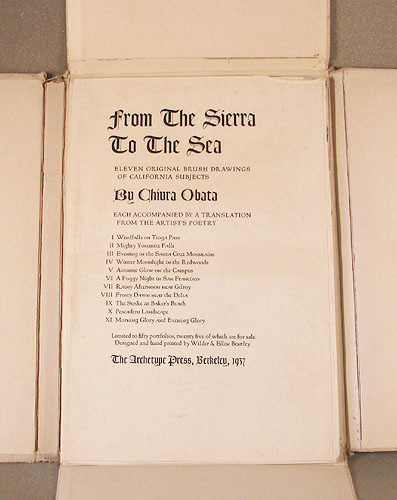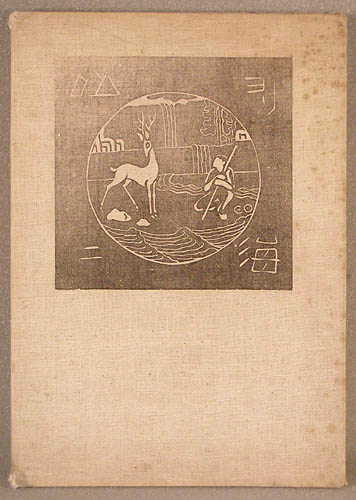|
Chiura Obata
From The Sierra To The Sea
Eleven original brush drawings of California subjects
SOLD |

|
|
Beautiful set of California landscapes by Japanese-American painter Chiura Obata. Each piece is hand painted by the artist and is accompanied by a translation of the artist's poetry. The eleven originals are preserved in a cloth-covered folder. designed
and hand-printed by Wilder & Ellen Bentley. |

|
|
Only 50 sets were published, and only 25 offered for sale to the public. This particular set came from a private family in Berkeley, CA.
Paintings are in very good condition. Folder is worn from age, with some foxing and insect damage on corners of inside covers.
dimensions: paintings approx. 10 1/2" wide x 15 1/2" tall folder approx. 11 1/4" wide x 16 1/4"tall
|

|
|
Chiura Obata (1885 - 1975) was a well-known Japanese-American artist. He came to the United States in 1903 at age 18. After working as an illustrator and commercial decorator, he had a successful career as a painter. Obata was a faculty member in the Art Department at the University of California at Berkely from 1932 to 1953. During World War II, he spent over a year in internment camps. After his retirement, he continued to paint and to lead group tours to Japan to see gardens and art. Obata was born in 1885 in Sendai, Japan. He was the youngest of a large family. As a child he showed a natural inclination for drawing, and was adopted by his older brother, Rokuichi, who was himself an artist. At the age of seven he began his formal training by a master painter in the art of sumi-e, Japanese ink and brush painting. Obata ran away from home at the age of 14 to avoid being put into military school. In Tokyo, he became apprenticed to the painter Tanryo Murata for three years. He also studied with Kogyo Terasaki and Goho Hasimoto. He was trained in Western as well as Japanese art, painting throughout his life with the Western influence. In 1903, Obata came to the United States, arriving initially in Seattle, planning to study American art before continuing to Paris to study European art. When he got to San Francisco, he found work as a domestic servant in a household, with the pay of $1.50 per week plus room and board. He was one of the founders of the Fuji Club, the first Japanese-American baseball team on the mainland in America. In 1906, Obata made on-site sketches of the aftermath of San Francisco earthquake. In 1909 he worked at the hops fields in the Sacramento Valley. Eventually, Obata was able to earn his living in California as an illustrator for different newspapers, including San Francisco's two Japanese newspapers, The New World and the Japanese American, and as commercial designer. As a designer, he decorated the famous Oriental rooms for Gumps department store, and did similar work for the department stores Emporium and City of Paris. He designed "Jewel Rooms" for the G. T. Mars Co. and one in Hotel Ambassador. He made five large murals for the Toyo Kisen Kaisha Steamship Co. and for the Iwata Dry Goods Co. From 1915-1917 Obata was illustrator and cover page designer for the magazine Japan, published for the Toyo Kisen Kaisha Steamship Co., during which time he turned out about 3000 illustrations and numerous cover designs. During the 1920s, Obata spent much time painting landscapes throughout California. In 1921, he co-founded the East West Art Society in San Francisco. He spent the summer of 1927 on a sketching tour of Yosemite and the Sierra high country, producing over 100 new paintings. He had been invited on the trip by Worth Ryder, who was a professor of art at UC Berkeley, who had become a friend. The first exhibition Obata had for American audiences was in the following year, 1928. In 1928, after his father's death, Obata returned to Japan. There he supervised the production of 35 colored woodblock prints of California landscapes for his "World Landscape Series". The majority of the prints are views of Yosemite National Park in California. The prints were published in limited editions of 100 by the Takamizawa Print Works in Japan. They were exhibited at the Eighty-Seventh Annual Exhibition at Ueno Park in Tokyo in 1930. His painting of Lake Basin in the High Sierra won first prize in the exhibition. He left Tokyo shortly thereafter. Beginning in 1930, Obata had many exhibitions in California, which were very successful. One in 1931, at the California Palace of the Legion of Honor, was a large exhibit with both his work and the work of his father, Rokuichi. In 1932 Obata was appointed as an instructor in the Art Department at the University of California, Berkeley. Between 1930 and 1941, one-man exhibitions were held in numerous locations. Obata and his wife Haruko ran an art supply store on Telegraph Avenue in Berkeley, from which his wife offered lessons in ikebana. The shop was the target of a gun shot after the Pearl Harbor attack in December 1941, and eventually the Obatas were forced to close it and cancel all classes. Executive Order 9066 led to Obata organizing a large sale of his many paintings and woodblock prints. He donated the profits from the sale to a campus student fund. University President Robert Gordon Sproul, a friend of the Obatas, offered to store many of the remaining works. In April 1942, Obata was interned at the Tanforan detention center. By May, he and fellow artists were able to create an art school that had 600 students, entirely with their own money and with donations from the outside from friends from U.C. Berkeley. The school was so successful that they were able to exhibit the artwork outside the camp in July. In September 1942, Obata was moved to the Topaz War Relocation Center in Topaz, Utah. There Obata was the founder and Director of The Topaz Art School, which had 16 artist / instructors who taught 23 subjects to over 600 students. During his internment, Obata made about hundred sketches and paintings. In 1945, when the military exclusion ban was lifted, Obata was reinstated as an instructor at U.C. Berkeley. In 1949 he was promoted to Associate Professor of Art. In 1950, he and his wife moved out of the attic apartment of a friend, purchasing a house in the Elmwood district in Berkeley, where they had lived before the war. His one-man shows continued, as did his sketching and painting trips in the high country, often with the Sierra Club. In 1953 he retired as Professor Emeritus from U.C. Berkeley. In 1954 he became a naturalized citizen. Obata played a pivotal role in introducing Japanese art techniques and aesthetics to other artists in California. These techniques and aesthetics became one of the distinctive characteristics of the California Watercolor School. From 1955 to 1970, Obata traveled throughout California, giving lectures and demonstrations on Japanese brush painting, and leading tours. In 1965 he received the Order of the Sacred Treasure, 5th Class, Emperor's Award, for promoting good will and cultural understanding between the United States and Japan. He died in 1975, aged 90. Posthumous exhibitions of Obata's works have been organized at the Oakland Museum, The Smithsonian Institution, and, in 2000, at the M. H. de Young Memorial Museum in San Francisco, a retrospective of 100 ink and brush paintings, large scrolls and color woodblock prints. In April 2004, The National Steinbeck Center museum had an exhibition in celebration of Obata and his love of the California landscape. In 2007 there was an exhibit in Yosemite National Park. |
|
![]()
![]()
All pages on this web site are copyright 1998 to 2016 by Williams Gallery West